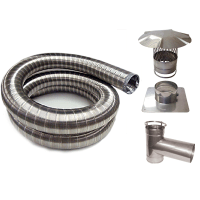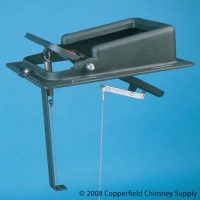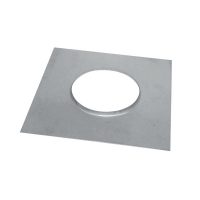Chimney Caps
What is a Chimney Cap?
A chimney cap is a protective covering which fits at the top of your chimney enclosure. They are typically fashioned out of stainless steel, copper, or galvanized metals; and come designed with a mesh screen to inhibit airborne hearth sparks, nesting outdoor animals, and damaging precipitation and debris from interfering with the overall safety and longetivity of your fireplace’s necessary venting system.
Why is it so crucial to keep sparks confined to your chimney and these other elements out? While you are toasting marshmallows and sharing intimate discussions by the glow of your fireplace’s hearth, quite a bit more is happening in the venting chamber of your chimney. The sparks produced from burning wood or faux logs will sometimes reach to your chimney’s top, and if not properly stopped, can ignite the flammable material surrounding your chimney wall, such as your roof and house’s construction. And all it takes is one airborne spark. Nesting animals such as squirrels and birds can find a sheltered refuge in your chimney’s top, usually without anyone being the wiser…until it’s too late. A chimney cap prevents them and their detrimental waste from taking up residence, thereby preventing foul odors and the mites that waste brings. Your chimney top is also exposed to rain, snow, hail, and violent gusts of wind; year after year. Without a chimney cap to insulate your chimney from its effects, rain can soak into the mortar joints of your chimney’s construction, thereby loosening the bricks or stone of your masonry chimney. Or if you have a metal chimney, precipitation will lead to damaging rust; thereby rapidly deteriorating your chimney. Violent wind gusts whip leaves and assorted debris into your chimney. These flammable materials can rapidly suffocate your flue from its necessary fire by-product venting, leading to dangerous chimney fires and downdrafting of the trapped smoke into your home. Buying a chimney cap is a priceless and easy solution to preventing a whole Pandora’s Box-full of natural evils, such as: fire, disease, costly repair, and strife from entering the safe harbor of your family’s cozy home.
Types of Chimneys
The first step in finding yourself a chimney cap is determining what type of chimney your house has. This will determine what type of chimney cap will fit best. The most common type of chimney is a masonry chimney, which is constructed of brick, stone, or concrete. Metal Chimneys or factory-built chimneys are mass-produced, typically come with a pre-fit chimney cap, and must be used with one, due to the fact that metal is less resilient in relation to Mother Nature’s elements. Typically, for masonry chimneys, you’ll find that their corresponding chimney caps come in three basic sizes: 8″ x 8″, 8″ x 12″ and 12″ x 12″, though custom styles and fits are available also.
Types of Flues
Whether you have a masonry or factory-made metal chimney, it is also necessary to determine what type of flue it works from. This can be determined by simply looking down into your chimney’s depths.
Masonry chimneys will have either single or multi flues, and these flues will be either extended or not. The most common is the single flue chimney with an extended flue. This flue will simply and visibly extend out the top of your chimney, allowing easy chimney cap installation and fit by screws which tighten to the flue’s construction. Single flue chimneys without extended flues have a recessed interior flue construction and will require what is called a leg kit or bracket to for installation of your chimney cap. The decision about whether you enlist a leg kit or brackets is yours, but brackets are recommended as they provide more resiliency under varying wind and weather conditions. Multi flue chimneys with or without extended flues will, as the type suggests, have more than one flue (typically two) either protruding from your chimney top or recessed in its interior.
Factory-produced Metal Chimney will have one of three basic types of flue construction: double-wall solid-pack insulated chimney pipe, double-wall air-insulated chimney pipe, or triple-wall air-insulated chimney pipe. Looking down into the chimney, you’ll see either two or three layers or walls of metal. If there is a metal cap or insulation material between these layers, you have yourself a solid-pack insulated flue system. If there is nothing but air between your flue walls, it is an air-insulated flue system.
Measuring
After determining what type of chimney and what type of flue you have, the next step is measurement of the flue system. Whether single or multi, extended or recessed, you will almost always need to know the precise width and length dimensions in order to accurately fit your chimney for a cap. Take the measurements a couple times to ensure accuracy, because being just a fraction of a size off, will negate all the purposes you’ve enlisted your chimney cap to demonstrate.
Masonry Chimneys:·For a single flue with an extended flue: measure the width and length of the outside parameters of the flue, and match these to a specific chimney cap size.·For a single flue without an extended flue: measure the width and length of the inside parameters of the flue, match to a specific chimney cap size, and order the corresponding leg kit or brackets.·For multi flue systems with or without extended flues: measure the total outside width and length of the combined flues. If your multi-flue system has one or more extended flues, you must next measure how far the highest flue extends out the top of the chimney. It is crucial when choosing a cap for these systems that you depend upon the measurements of your total flue system, as well as the flues’ height measurements to see how deep your chimney cap should be.
Factory-made Metal Chimneys:·For a double-wall solid-pack insulated flue system: measure the diameter of the inner pipe. Then, measure the diameter of the outer pipe. The inner dimensions will be used to secure the proper fit, while the outer dimensions will give a wider secondary cap protection for your flue. ·For a double or triple-wall air insulated flue system: measure the diameter of the inner pipe. Then, measure the diameter of the outer pipe. The inner dimensions will be used to secure the proper fit, while the outer dimensions will give a wider secondary cap protection for your flue.
Materials
Chimney caps come in a variety of materials depending on your aesthetic, function, and cost preferences. Galvanized metal flue caps are the most cost-effective and simple choice; but provide basic function without regard to aesthetics, will rust, and won’t last past the short-term. Stainless steel chimney cap construction is more middle-of-the-road cost-wise, and subsequently offers a more gratifying visual appeal, and will last much longer through varying elements and time. Copper chimney caps are the most expensive choice, but because of this offer: a hard-enduring quality, can be weathered naturally or coated with a special copper protectant to maintain the original color and shine. Stainless steel and copper constructed chimney caps do, more often than not, come with an extended warranty; and are the best way to go in the way of your chimney’s longetivity and your home and family’s safety.
Chimney Cap Types
Chimney caps also come in a variety of functions according to your cap preferences. There is the standard chimney cap which typically includes a screening material to further ward off elements and critters, is the most cost-effective, comes in a variety of materials, and takes care of your most basic chimney needs as far as insulation and protection is concerned. Draft increasing caps or vacuum chimney caps are more specific to a chimney that has difficulty, for one reason or another, drafting smoke up and out of your home. These chimney caps produce a stronger updraft, and are most often used with metal chimneys, though those with masonry chimneys can employ specific manufacturer adapters. There are two different options to cure this common chimney affliction. You can either employ what is called a flue stretcher which will extend the length of your flue and remove it from the influence of nearby or dual chimneys. This is a great option if you live in a dense city or have multi-floor fireplaces. Another option is a device which will decrease the downdraft by deflecting it within special cap fins, and subsequently suck excessive smoke out of your chimney. You may opt for a cap with an integral damper mechanism to replace a missing or loose-fitting damper system in your chimney. This type of chimney cap, once in place, will cap the previously wasted energy, restore the necessary damper functions, and insulate your home from the elements. Most come complete with a lever you’ll need to install on your fireplace wall, which activates effective use of the damper. Typically, those with older fireplaces will enlist these dual-purpose caps to gently restore an older fireplace.






